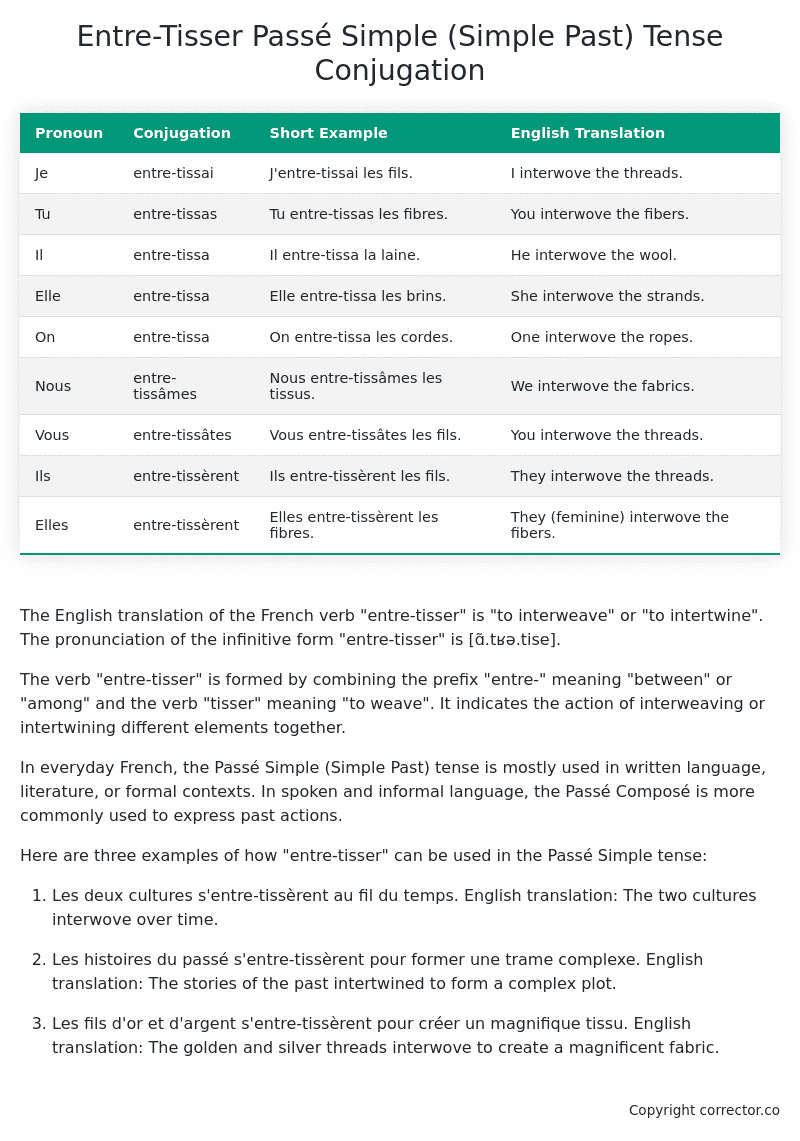Passé Simple (Simple Past) Tense Conjugation of the French Verb entre-tisser
Introduction to the verb entre-tisser
The English translation of the French verb “entre-tisser” is “to interweave” or “to intertwine”. The pronunciation of the infinitive form “entre-tisser” is [ɑ̃.tʁə.tise].
The verb “entre-tisser” is formed by combining the prefix “entre-” meaning “between” or “among” and the verb “tisser” meaning “to weave”. It indicates the action of interweaving or intertwining different elements together.
In everyday French, the Passé Simple (Simple Past) tense is mostly used in written language, literature, or formal contexts. In spoken and informal language, the Passé Composé is more commonly used to express past actions.
Here are three examples of how “entre-tisser” can be used in the Passé Simple tense:
-
Les deux cultures s’entre-tissèrent au fil du temps.
English translation: The two cultures interwove over time. -
Les histoires du passé s’entre-tissèrent pour former une trame complexe.
English translation: The stories of the past intertwined to form a complex plot. -
Les fils d’or et d’argent s’entre-tissèrent pour créer un magnifique tissu.
English translation: The golden and silver threads interwove to create a magnificent fabric.
Table of the Passé Simple (Simple Past) Tense Conjugation of entre-tisser
| Pronoun | Conjugation | Short Example | English Translation |
|---|---|---|---|
| Je | entre-tissai | J’entre-tissai les fils. | I interwove the threads. |
| Tu | entre-tissas | Tu entre-tissas les fibres. | You interwove the fibers. |
| Il | entre-tissa | Il entre-tissa la laine. | He interwove the wool. |
| Elle | entre-tissa | Elle entre-tissa les brins. | She interwove the strands. |
| On | entre-tissa | On entre-tissa les cordes. | One interwove the ropes. |
| Nous | entre-tissâmes | Nous entre-tissâmes les tissus. | We interwove the fabrics. |
| Vous | entre-tissâtes | Vous entre-tissâtes les fils. | You interwove the threads. |
| Ils | entre-tissèrent | Ils entre-tissèrent les fils. | They interwove the threads. |
| Elles | entre-tissèrent | Elles entre-tissèrent les fibres. | They (feminine) interwove the fibers. |
Other Conjugations for Entre-Tisser.
Le Present (Present Tense) Conjugation of the French Verb entre-tisser
Imparfait (Imperfect) Tense Conjugation of the French Verb entre-tisser
Passé Simple (Simple Past) Tense Conjugation of the French Verb entre-tisser (You’re reading it right now!)
Passé Composé (Present Perfect) Tense Conjugation of the French Verb entre-tisser
Futur Simple (Simple Future) Tense Conjugation of the French Verb entre-tisser
Futur Proche (Near Future) Tense Conjugation of the French Verb entre-tisser
Plus-que-parfait (Pluperfect) Tense Conjugation of the French Verb entre-tisser
Passé Antérieur (Past Anterior) Tense Conjugation of the French Verb entre-tisser
Futur Antérieur (Future Anterior) Tense Conjugation of the French Verb entre-tisser
Subjonctif Présent (Subjunctive Present) Tense Conjugation of the French Verb entre-tisser
Subjonctif Passé (Subjunctive Past) Tense Conjugation of the French Verb entre-tisser
Subjonctif Imparfait (Subjunctive Imperfect) Tense Conjugation of the French Verb entre-tisser
Conditionnel Présent (Conditional Present) Tense Conjugation of the French Verb entre-tisser
Conditionnel Passé (Conditional Past) Tense Conjugation of the French Verb entre-tisser
Conditionnel Passé II (Conditional Past II) Tense Conjugation of the French Verb entre-tisser
L’impératif Présent (Imperative Present) Tense Conjugation of the French Verb entre-tisser
L’impératif Passé (Imperative Past) Tense Conjugation of the French Verb entre-tisser
L’infinitif Présent (Infinitive Present) Tense Conjugation of the French Verb entre-tisser
L’infinitif Passé (Infinitive Past) Tense Conjugation of the French Verb entre-tisser
Le Participe Présent (Present Participle) Tense Conjugation of the French Verb entre-tisser
Le Participe Passé (Past Participle) Tense Conjugation of the French Verb entre-tisser
Struggling with French verbs or the language in general? Why not use our free French Grammar Checker – no registration required!
Get a FREE Download Study Sheet of this Conjugation 🔥
Simply right click the image below, click “save image” and get your free reference for the entre-tisser Passé Simple tense conjugation!

Entre-Tisser – About the French Passé Simple (Simple Past) Tense
Formation
Usage
Narration
Historical Context
Interactions with other tenses
Passé Composé
Imparfait
Conditional and Subjunctive
Summary
I hope you enjoyed this article on the verb entre-tisser. Still in a learning mood? Check out another TOTALLY random French verb conjugation!


